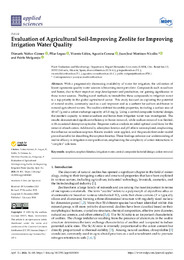Por favor, use este identificador para citar o enlazar este ítem:
https://hdl.handle.net/11000/34465Registro completo de metadatos
| Campo DC | Valor | Lengua/Idioma |
|---|---|---|
| dc.contributor.author | Núñez-Gómez, Dámaris | - |
| dc.contributor.author | Legua, Pilar | - |
| dc.contributor.author | Lidón Noguera, Vicente | - |
| dc.contributor.author | Conesa Martinez, Agustin | - |
| dc.contributor.author | Martinez Nicolas, Juan Jose | - |
| dc.contributor.author | Melgarejo Moreno, Pablo | - |
| dc.contributor.other | Departamentos de la UMH::Producción Vegetal y Microbiología | es_ES |
| dc.date.accessioned | 2025-01-15T09:19:29Z | - |
| dc.date.available | 2025-01-15T09:19:29Z | - |
| dc.date.created | 2024-01-03 | - |
| dc.identifier.issn | 2076-3417 | - |
| dc.identifier.uri | https://hdl.handle.net/11000/34465 | - |
| dc.description.abstract | With a progressively decreasing availability of water for irrigation, the utilization of lower agronomic quality water sources is becoming more prevalent. Compounds such as sodium and boron, due to their impact on crop development and production, are gaining significance in these water sources. Finding novel methods to immobilize these compounds in irrigation water is a top priority in the global agricultural sector. This study focused on exploring the potential of natural zeolite, commonly used as a soil improver and as a sorbent for sodium and boron in natural agricultural waters. The zeolite exhibited favorable properties, including a surface area of 40 m2/g and a cation-exchange capacity of 1.8 mg/g. Using a central composite factorial design, the zeolite’s capacity to remove sodium and boron from irrigation water was investigated. The results demonstrated significant efficiency in boron removal, while sodium removal was limited, with occasional desorption episodes. Response surface analysis revealed optimal conditions for the removal of each cation. Additionally, adsorption kinetics and pH effects were explored, emphasizing the influence on sodium sorption. Kinetic models were applied, and the pseudo-first-order model proved suitable for describing the sorption kinetics. These findings enhance our understanding of zeolite efficacy in irrigation water purification, emphasizing the complexity of cation interactions in “complex” solutions | es_ES |
| dc.format | application/pdf | es_ES |
| dc.format.extent | 16 | es_ES |
| dc.language.iso | eng | es_ES |
| dc.publisher | MDPI | es_ES |
| dc.rights | info:eu-repo/semantics/openAccess | es_ES |
| dc.rights | Attribution-NonCommercial-NoDerivatives 4.0 Internacional | * |
| dc.rights.uri | http://creativecommons.org/licenses/by-nc-nd/4.0/ | * |
| dc.subject | Sorption | es_ES |
| dc.subject | Sorption kinetics | es_ES |
| dc.subject | Irrigation water | es_ES |
| dc.subject | Central composite factorial design | es_ES |
| dc.subject | Cation removal | es_ES |
| dc.title | Evaluation of Agricultural Soil-Improving Zeolite for Improving Irrigation Water Quality | es_ES |
| dc.title.alternative | Applied Sciences 2024, 14(1), 418 | es_ES |
| dc.type | info:eu-repo/semantics/article | es_ES |
| dc.relation.publisherversion | https://doi.org/10.3390/app14010418 | es_ES |

Ver/Abrir:
Applied sciences-Evaluation of agricultural soil-improving....pdf
1,25 MB
Adobe PDF
Compartir:
 La licencia se describe como: Atribución-NonComercial-NoDerivada 4.0 Internacional.
La licencia se describe como: Atribución-NonComercial-NoDerivada 4.0 Internacional.
.png)